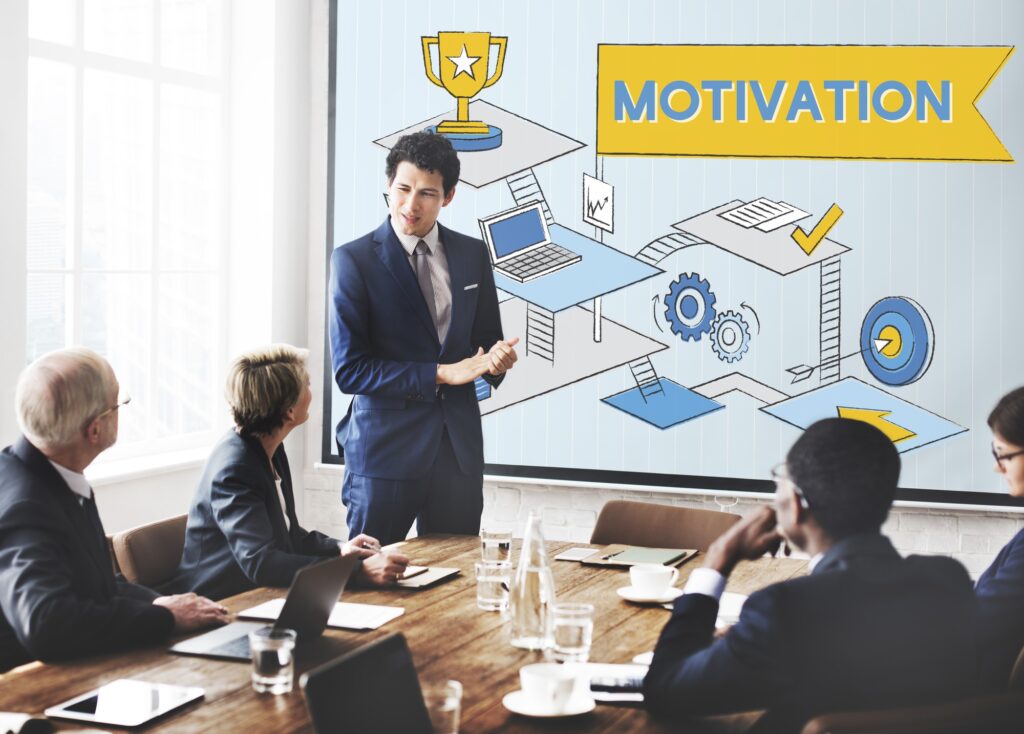Introduction
Employee motivation is a aspect of human resource management, influencing productivity, job satisfaction, and organizational success. This blog post aims to delve into the intricacies of employee, exploring its importance, historical background, theories, factors influencing motivation, strategies for motivating employees, the role of leadership, evaluating and sustaining motivation, and concluding with a call to action for HR professionals.
Employee Motivation Definitions
According to Edwin B.Flippo, “Motivation is the process of attempting to influence others to do your will through the possibility of gain or reward.”
According to Dalton E. McFarland, “Motivation refers to the way in which urges, drives, desires, aspirations, strivings or needs direct, control or explain the behavior of human beings.”
According to William G. Scout, “Motivation means a process of stimulating people to action to accomplish desired goals”.
According to Fred Luthans, “Motivation is the process which begins with a physiological or psychological need or deficiency which triggers behavior or a drive that is aimed at a goal or incentive.”
Table of Contents
Importance of Employee Motivation

Employee motivation is the driving force behind employee engagement, retention, and performance. Motivated employees are more likely to contribute positively to organizational goals, foster innovation, and create a positive work environment.
Historical Background
The concept of employee motivation dates back to the early 20th century when researchers began exploring the psychological factors influencing employee behavior. This led to the development of various motivational theories that continue to shape modern HR practices.
Employee Motivation theories
Notable theories of motivation include Maslow’s Hierarchy of Needs, Herzberg’s Two-Factor Theory, and Vroom’s Expectancy Theory, each offering unique insights into what drives employee behavior.
There are various theories that try to explain what motivates employees in the workplace. Some of the widely recognised ones include the following.
1. Maslow’s hierarchy of needs: This theory states that individuals are motivated by fulfilling five basic needs. These needs start from the most basic (physiological and safety) and move up the hierarchy towards self-actualisation.
The five needs are the following.
A. Physiological needs (example: food, water, shelter)
B. Safety needs (example: security, protection)
C. Love and belonging needs (example: friendship)
D. Esteem needs (example: self-respect, recognition)
E. Self-actualisation needs (example: fulfilment of one’s potential)
2. Heidelberg two-factor theory: This theory divides job factors into two categories: hygiene factors and motivators. Hygiene factors, such as salary and working conditions, must be met to prevent dissatisfaction. On the other hand, motivators, such as recognition and responsibility, drive job satisfaction.
3. Expectancy theory: The expectancy theory is a widely recognised framework that explains the factors influencing an individual’s motivation. According to this theory, an individual’s motivation is based on their belief that putting in more effort will result in better outcomes. However, for the person to be motivated, they must also value these outcomes.
4. Self-determination theory: This theory posits that individuals are motivated when they experience three feelings. The feelings are autonomy (control over their work), competence (the belief that they are capable), and relatedness (the sense of connection to others). When these three needs are met, individuals are more likely to be motivated and engaged in their work.
Factors Influencing Employee Motivation
1. Intrinsic Factors of employee motivation;
Recognition and Reward
Recognizing and rewarding employees for their hard work and achievements can boost morale, motivation, and loyalty.
Job Enrichment
Providing employees with challenging and meaningful tasks can increase job satisfaction and motivation.
Sense of Achievement
Acknowledging employees’ accomplishments and milestones can fuel their motivation to strive for further success.
2. Extrinsic Factors of employee motivation
Competitive Salary
Offering competitive salaries and benefits can attract top talent and motivate employees to perform at their best.
Job Security
Providing a stable work environment can alleviate employee concerns and enhance their motivation to contribute to the organization.
Benefits and Perks
Offering additional benefits and perks such as flexible work hours, wellness programs, or career development opportunities can enhance employee motivation.
Employee Motivation Strategies

Some of the important employee motivation strategies are given below.
1. Goal Setting;
Clear Objectives
Setting clear and achievable goals helps employees understand expectations and stay motivated to achieve them.
SMART Goals
SMART goals are specific, measurable, achievable, relevant, and time-bound, providing a framework for effective goal setting.
Feedback Mechanisms
Regular feedback on performance and progress towards goals helps employees stay on track and adjust their efforts accordingly.
2. Employee Development;
Training and Development Programs
Investing in employees’ skills and knowledge through training programs can enhance their motivation and performance.
Career Growth Opportunities
Providing opportunities for career advancement and professional development can motivate employees to excel in their roles.
Mentoring and Coaching
Pairing employees with mentors or coaches can offer guidance, support, and inspiration to help them reach their full potential.
3. Work Environment;
Positive Culture
Fostering a positive work culture characterized by respect, collaboration, and open communication can boost employee morale and motivation.
Open Communication
Encouraging transparent communication channels between employees and management fosters trust, engagement, and motivation.
Work-Life Balance
Supporting work-life balance initiatives like flexible scheduling or wellness programs can help employees maintain motivation and well-being.
The Role of Leadership in Motivating Employees
Effective leadership plays a vital role in motivating employees and driving organizational success. Different leadership styles can influence employee morale, engagement, and motivation.
1. Transformational Leadership
Transformational leaders inspire and motivate employees through vision, charisma, and emotional intelligence.
Inspirational Motivation
Inspiring employees to achieve common goals and aspirations can ignite their motivation and dedication.
Individualized Consideration
Showing empathy and understanding towards individual employees’ needs and aspirations can enhance their motivation and job satisfaction.
Intellectual Stimulation
Encouraging employees to think creatively, challenge the status quo, and innovate can fuel their motivation and engagement.
2. Supportive Leadership
Supportive leaders provide encouragement, guidance, and resources to help employees succeed and stay motivated.
Empathy and Understanding
Demonstrating empathy and understanding towards employees’ challenges and concerns can build trust and enhance their motivation.
Conflict Resolution Skills
Resolving conflicts promptly and effectively can maintain a harmonious work environment and prevent demotivation among employees.
Providing Resources
Ensuring employees have the necessary tools, resources, and support to perform their jobs effectively can boost their motivation and productivity.
3. Collaborative Leadership
Collaborative leaders involve employees in decision-making, value their input, and empower them to contribute to the organization’s success.
Team Building
Building cohesive teams through collaboration, mutual respect, and shared goals can enhance employee motivation and performance.
Encouraging Innovation
Empowering employees to think innovatively, take risks, and contribute new ideas can stimulate their motivation and creativity.
Shared Decision Making
Involving employees in decision-making processes and considering their perspectives can increase their sense of ownership and motivation.
Evaluating and Sustaining Employee Motivation
Maintaining employee motivation requires ongoing evaluation, engagement, and improvement strategies to sustain high levels of performance and job satisfaction.

1. Performance Evaluation;
Regular Feedback
Providing frequent feedback on performance, recognizing achievements, and addressing concerns promptly can sustain employee motivation.
Performance Appraisals
Conducting regular performance appraisals, setting goals, and discussing growth opportunities can motivate employees to excel.
Recognition Programs
Implementing recognition programs to celebrate employee achievements, milestones, and contributions can boost morale and motivation.
2. Employee Engagement;
Surveys and Feedback
Conducting employee engagement surveys, soliciting feedback, and acting on suggestions can improve motivation and job satisfaction.
Employee Involvement Initiatives
Involving employees in decision-making processes, problem-solving, and goal-setting can enhance their sense of ownership and motivation.
Celebrating Success
Recognizing and celebrating team and individual successes reinforces a culture of appreciation, motivation, and collaboration.
3. Continuous Improvement;
Learning from Failures
Encouraging a culture of continuous learning, experimentation, and growth mindset can help employees learn from failures and stay motivated.
Adapting Strategies
Remaining flexible and adaptive to changing circumstances, feedback, and employee needs can sustain motivation and engagement.
Building Resilience
Supporting employees in developing resilience, coping skills, and mental well-being can enhance their motivation and ability to overcome challenges.
Conclusion
Employee motivation is a multifaceted and dynamic aspect of human resource management that underpins organizational success and employee well-being. HR professionals play a crucial role in fostering motivation, engaging employees, and creating a positive work environment. By implementing effective strategies, cultivating strong leadership, and sustaining motivation through continuous improvement, organizations can empower employees to thrive and contribute meaningfully to their success.
Call to Action for HR Professionals
As HR professionals, it is essential to prioritize employee motivation, engagement, and well-being in organizational practices. By adopting a holistic approach to motivation, implementing tailored strategies, and leveraging leadership skills effectively, HR professionals can drive positive change, enhance employee performance, and create a culture of motivation and success.
Future Outlook for Employee Motivation
As workplace dynamics evolve, the future of employee motivation will continue to be shaped by technological advancements, remote work trends, and changing employee preferences. HR professionals must adapt, innovate, and stay proactive in addressing emerging challenges, harnessing opportunities, and sustaining motivation in the digital age.
FAQs
What is the difference between intrinsic and extrinsic motivation?
Intrinsic motivation stems from internal factors like personal growth, achievement, and autonomy, while extrinsic motivation comes from external rewards or incentives such as salary, recognition, or benefits.
How can leaders boost employee motivation in a remote work setting?
Leaders can boost employee motivation in a remote work setting by fostering clear communication, providing regular feedback, creating virtual social connections, and offering remote-friendly perks and benefits.
What are the common challenges in maintaining long-term employee motivation?
Common challenges in maintaining long-term employee motivation include burnout, lack of recognition, unclear goals, poor communication, limited growth opportunities, and disengagement. By addressing these challenges proactively, organizations can sustain motivation and ensure long-term success.